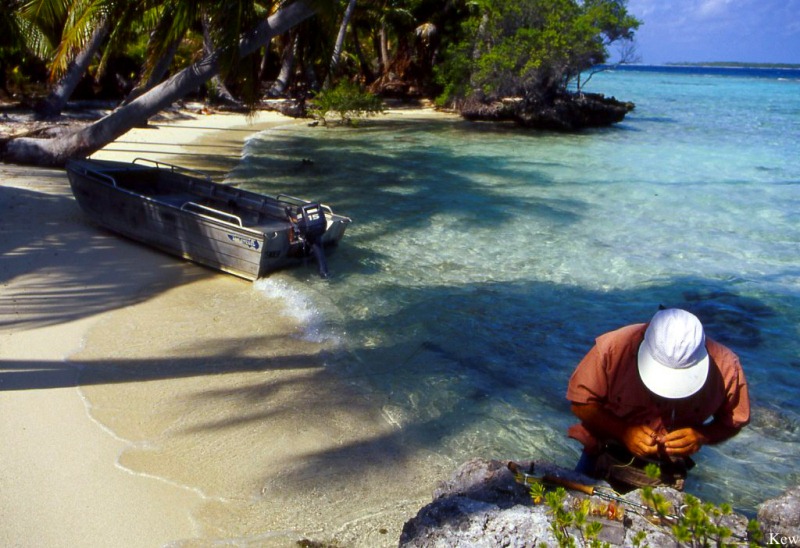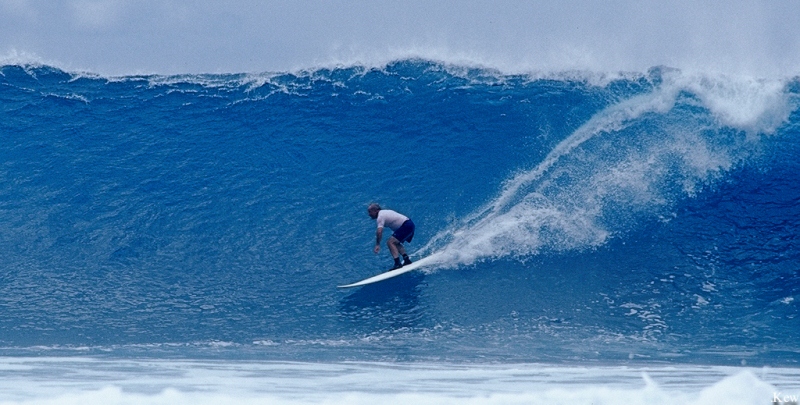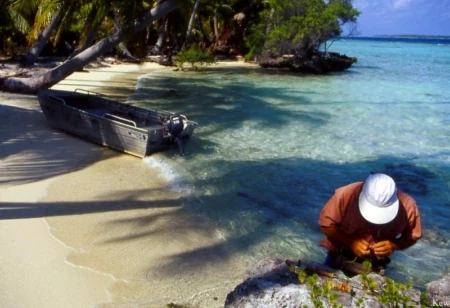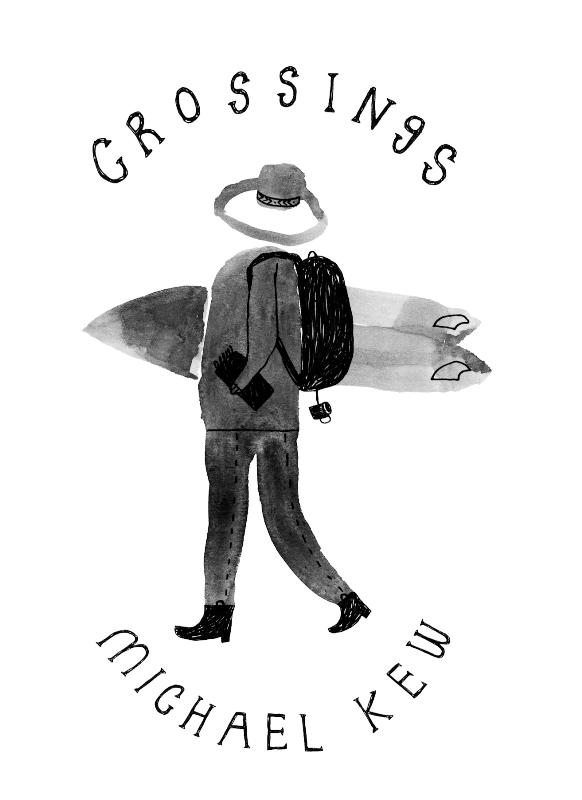Excerpt from “Crossings” by Michael Kew
by 
From “Coral Refuge, Ocean Deep,” Chapter 8
This atoll is on the way to nowhere except the crossroads of romance and adventure. Après-surf and brunch, Yvon and I board the skiff and buzz into close range; Francois kills the motor. Adrift within the lagoon’s turquoise comfort, far from the roily pass and its fish traps, a broad, sandy flat is declared quintessential bonefish domain. Nearby, a few decayed fishing shacks face dense coconut palms—Polynesia’s most important tree—hinting a wistful regard to overfishing and a once-seemingly endless bounty.
“Well, there’s no fish here compared to…I mean, you can go all day trolling out there and you don’t catch a fish sometimes,” Yvon says, absorbing the scene. “If you were at a place like Christmas Island or some of the less-inhabited places—or some places that haven’t been fished out—you can’t go a quarter-mile without hooking up with something. There’s still some pelagic fish here and stuff, but it’s pretty well fished-out, especially the closer you get to Tahiti.”
Exiting the skiff, we infiltrate with fly rods, cameras, and dim expectancy. Yvon wades and searches, casting over the sand and coral knobs.
[Above: Yvon Chouinard preps for a day of bonefishing. Photo: Michael Kew]
“Bonefishing is like a combination of hunting and fishing,” he says. “You’re just searching all day. Your perception gets real acute looking for these fish. When you finally get one, they’re so strong—they’re just amazing.”
Casting several times on different days in different lagoons, not a single bonefish is landed during the voyage. Yvon shrugs. “Hell, I don’t know. Maybe it’s like Hawaii…maybe bonefishing here is a seasonal thing, too.”
The surf is not. Year-round, Tuamotu is blitzed with swell from all directions. Winter, spring, summer, autumn—doesn’t matter. To date, several diamonds have been mined and more await discovery. On our first day at sea, Chris O’Callaghan spells it out:
“Since I’ve had my boat, we’ve been able to go to many places the freighters don’t go to, because they only go where there’s civilization. There’s no other way to explore other than the way we’re doing it, because there’s no other way to get here. No planes, no boats, no nothing—you’ve got to have your own boat.”
* * *
A morning late in the voyage. Terns aloft, first light burns the horizon—the edge of infinitude. Roused by warm sun on my face, awakening unfolds to a dream outside my porthole. Oily-glass lagoon resonates, ablaze with dawn. Sole sounds are muffled wave action and the gentle lapping of water against hull. I exit the bunk and head for the bow.
The young air is heavy, windless, hot. Sweat ensues. This, an odyssey through time, represents volumes from my pre-travel life, knowing that this exists somewhere, but lacking memories and passport stamps. Storybook longing over seductive tropical imagery and lucid tales of the South Pacific precede anyone’s baptism in Polynesian seas.
Yvon, a veteran traveler, appears from below.
“Ah, this is paradise for me,” he nods. “When I was a kid, I read every book I could find on the South Pacific, and this is what I wanted to do. I wanted to disappear out here someday (laughs). My wife doesn’t like the tropics, though. Otherwise, I’d be here all the time. Go with my fly rod and my surfboard; find some island that had good surf on it, good bonefishing….”
The entire image is erased as the fantasy gives way: Slicing toward the pass in the dinghy, an azure right-hander sprouts from the depths and heaves onto the reef, visible through the wave itself. Francois idles us into the lineup.

[The other half of Yvon's idea of paradise. Photo: Michael Kew]
Much later, cracking an iced Hinano with twilight, Chris reflects:
“I think it’s every surfer’s dream…I see the same kind of waves that we all used to draw during math class in school. The teacher’s talking up at the front, and you’re drawing little palm trees hanging over with these lines peeling around the point. I actually get to see waves like that in real life, on a regular basis, with nobody out.
“And the colors here, mate—every single shade of blue in the spectrum. From the sky all the way down to the depths of the sea, the blues are just amazing….”
We motor into Tahiti’s Marina Taina 30 hours later, Fa’aa International Airport beckoning beneath dreary overcast and the sticky grime of tropical civilization. The others soon depart for Los Angeles; tonight, my journey remains.
Michael Kew is a writer, photographer, and filmmaker who first became involved with media production when he was 12. In the 28 years since, Kew has been published extensively in many surfing and international travel magazines, newspapers, websites, and books, including his own self-published Crossings. Kew’s second travel book is set for release later this year. He lives with his three cats in a cabin on the southern Oregon coast.
Previous excerpts from Kew's book:
The Five Pillars of Lakshadweep
Coral Refuge, Ocean Deep


